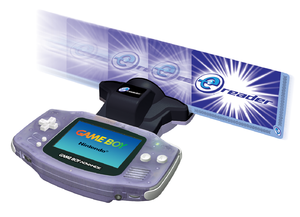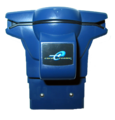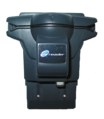E-Reader: Difference between revisions
(→Images) |
Tags: Mobile edit Mobile web edit |
||
| (6 intermediate revisions by 6 users not shown) | |||
| Line 3: | Line 3: | ||
The '''e-Reader''' (Japanese: '''カードeリーダー''' ''Card e Reader'') is a peripheral for the [[Game Boy Advance]] that is used to scan special cards in order to unlock new features in existing games, add new features to games that have e-Reader functionality, or to play minigames on the e-Reader itself. | The '''e-Reader''' (Japanese: '''カードeリーダー''' ''Card e Reader'') is a peripheral for the [[Game Boy Advance]] that is used to scan special cards in order to unlock new features in existing games, add new features to games that have e-Reader functionality, or to play minigames on the e-Reader itself. | ||
Developed jointly by [[Creatures, Inc.]], [[HAL Laboratory, Inc.]], and {{wp|Olympus Corporation|Olympus}}, the original Japanese Card e Reader lacked the [[Game Link Cable]] functionality when it was released in December 2001. A re-release, the Card e Reader+, added a Game Link Cable port, allowing it to connect to a second Game Boy Advance or a [[Nintendo GameCube]] using the same Game Link Cables that the Game Boy Advance system alone would use. This version of the e-Reader was the one that was later released in the West as the e-Reader in September 2002. | Developed jointly by [[Creatures, Inc.]], [[HAL Laboratory, Inc.]], and {{wp|Olympus Corporation|Olympus}}, the original Japanese Card e-Reader lacked the [[Game Link Cable]] functionality when it was released in December 2001. A re-release, the Card e Reader+, added a Game Link Cable port, allowing it to connect to a second Game Boy Advance or a [[Nintendo GameCube]] using the same Game Link Cables that the Game Boy Advance system alone would use. This version of the e-Reader was the one that was later released in the West as the e-Reader in September 2002. | ||
Though it was popular in Japan, with e-Cards released until the end of the Game Boy Advance's lifespan, the e-Reader proved to be unpopular in North America, leading to its discontinuation in 2004. e-Reader functionality, included in the Japanese versions of {{game2|FireRed|LeafGreen|Emerald}}, was removed from the English and other translations, as the compatible cards were never planned to be released. Due to this early discontinuation, the e-Reader was only released in North America and Australia, though e-Cards were released in Europe as well. | Though it was popular in Japan, with e-Cards released until the end of the Game Boy Advance's lifespan, the e-Reader proved to be unpopular in North America, leading to its discontinuation in 2004. e-Reader functionality, included in the Japanese versions of {{game2|FireRed|LeafGreen|Emerald}}, was removed from the English and other translations, as the compatible cards were never planned to be released. Due to this early discontinuation, the e-Reader was only released in North America and Australia, though e-Cards were released in Europe as well. | ||
| Line 14: | Line 14: | ||
* The short strip holds 1.4 kilobytes of data. | * The short strip holds 1.4 kilobytes of data. | ||
* Passthrough game link port | * Passthrough game link port | ||
<ref>[https://web.archive.org/web/20080917112617/http://www.vidgame.net/NINTENDO/e_reader.htm Vidgame.net: Nintendo E-Reader]</ref> | |||
==English | ==English release== | ||
To promote the e-Reader prior to its English release, kiosks with built-in Game Boy Advance consoles and e-Reader devices used three placeholder e-Cards to demonstrate its functionality: a "Manhole" card along with [[Pichu (Expedition 58)]] and [[Hoppip (Expedition 112)]]. These three cards, which are slightly thicker than usual Pokémon cards and have a glossy finish, were all hole-punched so they could be attached to the device via a cable to prevent loss or theft whilst allowing enough flexibility for the cards to still be swiped. | To promote the e-Reader prior to its English release, kiosks with built-in Game Boy Advance consoles and e-Reader devices used three placeholder e-Cards to demonstrate its functionality: a "Manhole" card along with [[Pichu (Expedition 58)]] and [[Hoppip (Expedition 112)]]. These three cards, which are slightly thicker than usual Pokémon cards and have a glossy finish, were all hole-punched so they could be attached to the device via a cable to prevent loss or theft whilst allowing enough flexibility for the cards to still be swiped. | ||
It's a common misconception that these cards were the same cards handed out at the E3 | It's a common misconception that these cards were the same cards handed out at the E3 convention in 2002, which also featured a Kirby e-Card, but the Pokémon cards from that event are regular thickness cards without a glossy finish and have a Japanese back instead of regular English back. | ||
==Pokémon e-Cards== | ==Pokémon e-Cards== | ||
| Line 35: | Line 36: | ||
* The {{TCG|McDonald's Pokémon-e Minimum Pack}} (Japan) | * The {{TCG|McDonald's Pokémon-e Minimum Pack}} (Japan) | ||
* The {{TCG|Theater Limited VS Pack}} (Japan, select cards only) | * The {{TCG|Theater Limited VS Pack}} (Japan, select cards only) | ||
* Special cards containing extra features for the [[Smeargle Paint]] minigame in | * Special cards containing extra features for the [[Smeargle Paint]] minigame in {{g|Channel}} | ||
* Special cards allowing a player to increase the likelihood of special events in | * Special cards allowing a player to increase the likelihood of special events in {{g|Pinball: Ruby & Sapphire}} | ||
* Two cards distributed with Pokémon Scoop's Winter 2004 magazine containing the Berry Program Update, fixing the [[Berry glitch]] in {{game|Ruby and Sapphire|s}}. | * Two cards distributed with Pokémon Scoop's Winter 2004 magazine containing the Berry Program Update, fixing the [[Berry glitch]] in {{game|Ruby and Sapphire|s}}. | ||
| Line 42: | Line 43: | ||
* The minigame [[Machop At Work]] was included with the purchase of an e-Reader in the United States. | * The minigame [[Machop At Work]] was included with the purchase of an e-Reader in the United States. | ||
* According to [[Nintendo Power]] v.169, it would take roughly 62,500 e-Reader cards to equal the data on one [[Nintendo GameCube|GameCube]] disc. | * According to [[Nintendo Power]] v.169, it would take roughly 62,500 e-Reader cards to equal the data on one [[Nintendo GameCube|GameCube]] disc. | ||
** However, this is a gross understatement when checked mathematically. Assuming the | ** However, this is a gross understatement when checked mathematically. Assuming the cards used have two long strips of 2.2KB each (for 4.4KB per card) it would take 331,819 e-Reader cards. | ||
* The device was originally going to be called the "Pokémon Card-e-Reader", and the only mentioned functionality for it was reading Pokémon TCG cards.<ref>[http://web.archive.org/web/20010611141753/http://www.nintendo.com/news/news_articles.jsp?articleID=3938 2001 e3 -- POKéMON CARD-E-READER Fact Sheet]</ref> | * The device was originally going to be called the "Pokémon Card-e-Reader", and the only mentioned functionality for it was reading Pokémon TCG cards.<ref>[http://web.archive.org/web/20010611141753/http://www.nintendo.com/news/news_articles.jsp?articleID=3938 2001 e3 -- POKéMON CARD-E-READER Fact Sheet]</ref> | ||
| Line 48: | Line 49: | ||
<gallery> | <gallery> | ||
Card e Reader.png|The original Japanese ''Card e Reader'' | Card e Reader.png|The original Japanese ''Card e Reader'' | ||
Card e Reader_Plus. | Card e Reader_Plus.png|The Japanese ''Card e Reader +'' | ||
E Reader.png|English language ''e-Reader'', based on the Japanese ''Card e Reader +'' | E Reader.png|English language ''e-Reader'', based on the Japanese ''Card e Reader +'' | ||
</gallery> | </gallery> | ||
| Line 62: | Line 63: | ||
[[de:Nintendo e-Reader]] | [[de:Nintendo e-Reader]] | ||
[[es:e-Reader]] | [[es:Nintendo e-Reader]] | ||
[[fr:E-Reader]] | [[fr:E-Reader]] | ||
[[it:E-Reader]] | [[it:E-Reader]] | ||
[[ja:カードeリーダー]] | [[ja:カードeリーダー]] | ||
[[zh:E卡刷卡器]] | [[zh:E卡刷卡器]] | ||
Latest revision as of 10:43, 11 March 2024
The e-Reader (Japanese: カードeリーダー Card e Reader) is a peripheral for the Game Boy Advance that is used to scan special cards in order to unlock new features in existing games, add new features to games that have e-Reader functionality, or to play minigames on the e-Reader itself.
Developed jointly by Creatures, Inc., HAL Laboratory, Inc., and Olympus, the original Japanese Card e-Reader lacked the Game Link Cable functionality when it was released in December 2001. A re-release, the Card e Reader+, added a Game Link Cable port, allowing it to connect to a second Game Boy Advance or a Nintendo GameCube using the same Game Link Cables that the Game Boy Advance system alone would use. This version of the e-Reader was the one that was later released in the West as the e-Reader in September 2002.
Though it was popular in Japan, with e-Cards released until the end of the Game Boy Advance's lifespan, the e-Reader proved to be unpopular in North America, leading to its discontinuation in 2004. e-Reader functionality, included in the Japanese versions of Pokémon FireRed, LeafGreen, and Emerald, was removed from the English and other translations, as the compatible cards were never planned to be released. Due to this early discontinuation, the e-Reader was only released in North America and Australia, though e-Cards were released in Europe as well.
Technical specifications
- "Dot Code Technology" (Optical scanning technology)
- 8 Megabit flash memory
- 64 Megabyte mask ROM
- The long strip on each e-Card holds 2.2 kilobytes of data.
- The short strip holds 1.4 kilobytes of data.
- Passthrough game link port
English release
To promote the e-Reader prior to its English release, kiosks with built-in Game Boy Advance consoles and e-Reader devices used three placeholder e-Cards to demonstrate its functionality: a "Manhole" card along with Pichu (Expedition 58) and Hoppip (Expedition 112). These three cards, which are slightly thicker than usual Pokémon cards and have a glossy finish, were all hole-punched so they could be attached to the device via a cable to prevent loss or theft whilst allowing enough flexibility for the cards to still be swiped.
It's a common misconception that these cards were the same cards handed out at the E3 convention in 2002, which also featured a Kirby e-Card, but the Pokémon cards from that event are regular thickness cards without a glossy finish and have a Japanese back instead of regular English back.
Pokémon e-Cards
- The Pokémon Battle e card series
- The Sample Set demonstration series
- The Expedition Base Set TCG expansion
- The Aquapolis TCG expansion
- The Skyridge TCG expansion
- The EX Ruby and Sapphire TCG expansion (Pokédex entries only)
- The EX Sandstorm TCG expansion (Pokédex entries only)
- The EX Dragon TCG expansion (Pokédex entries only)
- The EX Team Magma vs Team Aqua TCG expansion (Pokédex entries only, select cards only)
- Select Wizards Black Star Promos and Nintendo promotional TCG cards.
- The P Promotional cards (Japan)
- The McDonald's Pokémon-e Minimum Pack (Japan)
- The Theater Limited VS Pack (Japan, select cards only)
- Special cards containing extra features for the Smeargle Paint minigame in Pokémon Channel
- Special cards allowing a player to increase the likelihood of special events in Pokémon Pinball: Ruby & Sapphire
- Two cards distributed with Pokémon Scoop's Winter 2004 magazine containing the Berry Program Update, fixing the Berry glitch in Pokémon Ruby and Sapphire.
Trivia
- The minigame Machop At Work was included with the purchase of an e-Reader in the United States.
- According to Nintendo Power v.169, it would take roughly 62,500 e-Reader cards to equal the data on one GameCube disc.
- However, this is a gross understatement when checked mathematically. Assuming the cards used have two long strips of 2.2KB each (for 4.4KB per card) it would take 331,819 e-Reader cards.
- The device was originally going to be called the "Pokémon Card-e-Reader", and the only mentioned functionality for it was reading Pokémon TCG cards.[2]



